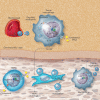Regulation of leucocyte homeostasis in the circulation
- PMID: 25750191
- PMCID: PMC4560027
- DOI: 10.1093/cvr/cvv099
Regulation of leucocyte homeostasis in the circulation
Abstract
The functions of blood cells extend well beyond the immune functions of leucocytes or the respiratory and hemostatic functions of erythrocytes and platelets. Seen as a whole, the bloodstream is in charge of nurturing and protecting all organs by carrying a mixture of cell populations in transit from one organ to another. To optimize these functions, evolution has provided blood and the vascular system that carries it with various mechanisms that ensure the appropriate influx and egress of cells into and from the circulation where and when needed. How this homeostatic control of blood is achieved has been the object of study for over a century, and although the major mechanisms that govern it are now fairly well understood, several new concepts and mediators have recently emerged that emphasize the dynamism of this liquid tissue. Here we review old and new concepts that relate to the maintenance and regulation of leucocyte homeostasis in blood and briefly discuss the mechanisms for platelets and red blood cells.
Keywords: Cholesterol metabolism; Leucocyte homeostasis; Leucocyte mobilization; Leucocyte recruitment.
Published on behalf of the European Society of Cardiology. All rights reserved. © The Author 2015. For permissions please email: journals.permissions@oup.com.
Figures


References
-
- Katayama Y, Battista M, Kao WM, Hidalgo A, Peired AJ, Thomas SA, Frenette PS. Signals from the sympathetic nervous system regulate hematopoietic stem cell egress from bone marrow. Cell 2006;124:407–421. - PubMed
Publication types
MeSH terms
Substances
Grants and funding
LinkOut - more resources
Full Text Sources
Other Literature Sources

